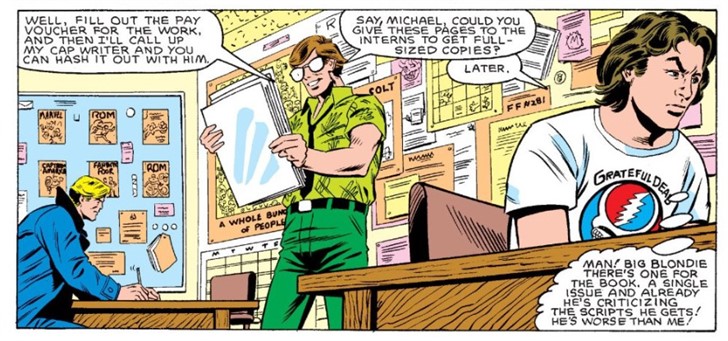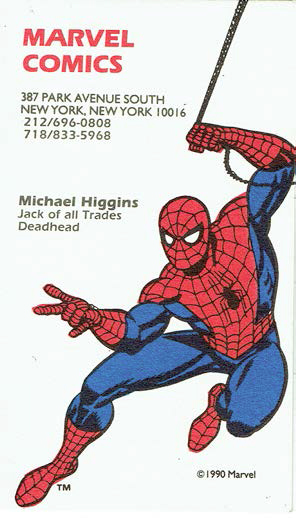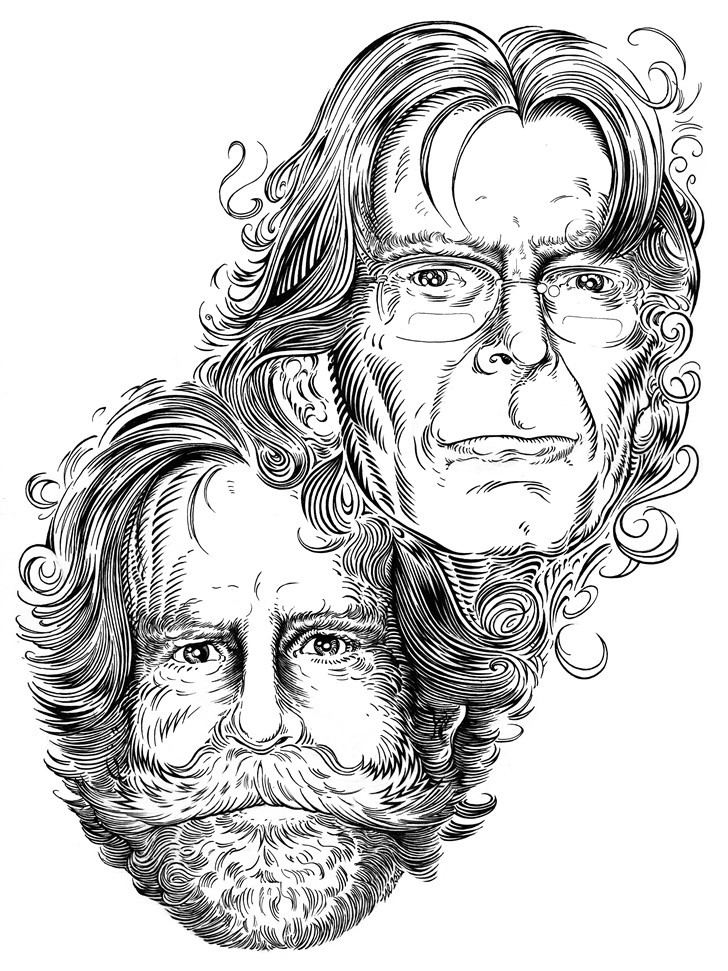Marvel’s Jack of All Trades and Resident Deadhead

The last issue of Relix explored a moment in Marvel Comics history when Captain America shared some positive sentiments about Grateful Dead fans. In issue No. 357 (September 1989), after it turned out that Nancy Rosenthal, the sister of Cap’s former girlfriend, who had gone missing, was not in peril but rather off on Dead tour, the superhero said to himself: “Considering all the alternatives, this country could use a lot more Deadheads.”
Writer Mark Gruenwald, who was not a Deadhead, passed away in 1996, so he is not available to share the genesis of this reference. However, his editor Ralph Macchio suggested that perhaps it was a nod to Mike Higgins, a longtime Marvel staffer and Dead fan.
While Higgins was not initially available to confirm this account, shortly after our issue went to print, he did chime in and offered, “Mark Gruenwald was a friend of mine and, while I don’t remember that reference, I am sure that’s a little nod to me.”
What follows is a conversation with Higgins, who worked at the company from 1977–1999, and whose official Marvel business card identified him as a “Jack of All Trades” and “Deadhead.” Both are accurate: Higgins occupied a variety of roles at the company, from letterer to editor. The latter designation is equally apt, as he attended over 360 Grateful Dead shows from 1978–1995, and he estimates that he’s seen at least as many performances by the band members in other incarnations over the years as well.

Your status as a Deadhead is referenced a few times over the years in various comics, letters pages and the like. Were you treated like an object of curiosity in the office?
It’s funny, in most of my life, I was identified as the guy who worked for Marvel Comics but, at Marvel Comics, I was identified as the guy who was into the Grateful Dead. I started at Marvel around the same time I got into the Grateful Dead, so they went hand in hand for me. I would spend three to four months totally immersed in Marvel, but then I could get totally out there for a set of shows and it was a different world. I’d be recharged and go back to putting out comic after comic for another three months. I could be in California for a set of Greek shows and only miss an afternoon of work.
The longest I was ever out of contact was for three weeks during the Europe ‘90 tour. I lettered every issue of Akira for Epic [a Marvel imprint] with the exception of the one issue that they needed me to do when I was in Europe in 1990. I had the book for about a week before I left for the tour, but I couldn’t start on it because I was still working full-time restoring the art for the hardcover reprint of Marvel Comics, No. 1. I left eight of the 64 pages unfinished when I left for the tour. Romita’s Raiders in the art department [led by John Romita Sr.] finished what I had started on those pages, and I went to Sweden. But, because of the Europe ‘90 tour, someone else lettered that one issue of Akira.
You make an appearance in Fantastic Four, No. 262 (Jan. 1984), which opens with (writer/penciller) John Byrne on the phone with you. Was there something in particular that led him to draw you wearing a Dead logo on your shirt?
I was the one who put the “Steal Your Face” [logo] on me in both of the shots. I was the assistant editor and, when the book came past me, I just added the Grateful Dead shirt. If you look above my head, to the right, is a small skull and roses and the beginning of the word “JER-ry,” whose birthday [Aug. 1] you’ll see noted to the left of my hand holding the phone.
You later show up in Captain America, No. 314 (Feb 1986), wearing that same shirt. You’re in the room with Cap’s alter ego, Steve Rogers, as part of a strange story arc in which he is working as an artist at Marvel. Did you draw the logo on yourself, again?
I did, indeed. I agree with you on the storyline. It had already been established somewhere that Captain America was a graphic artist, which I did not think was a very good idea. In my time, he was a cop. It made sense that Clark Kent was a reporter because he could get to the news, and it made sense for Cap to be a cop on the beat so that he could get to where he needed to be, but I don’t think there was a precedent for him being a commercial artist any time before someone just decided that. But Mark played with it. He wanted him to come into our office and draw Captain America.
We used to plot these over a lot of margaritas and what we called “slippy grease” because of the Jack Kirby drawing of the Joker from Super Powers, where he’s got a pump of slippy grease to fight the super heroes. We called the salsa slippy grease. We wanted to eat the salsa and chips, but they wouldn’t give us more salsa and chips unless we drank more margaritas, so we did a lot of plotting with a lot of margaritas in us. Mark was the writer, Mike Carlin was the editor and I was the assistant editor.
Were there other occasions when you dropped in Grateful Dead references of one sort or another?
When I worked on Conan, I would put spells in the background, like writing “Grateful Dead Go to Heaven” backward and stuff like that. Captain America, No. 314 also has this Jack O’ Roses image that I snuck into the background.
The first book I ever wrote was G.I. Joe and The Transformers. I had turned it down for some time and Mike Carlin told me if I turned it down one more time, he would give it to someone else whose work I had been rewriting for a while. So I decided if I’m going to be rewriting it anyhow, I might as well write it and take the money. I made references to music in my titles. The first issue was called “Blood on the Tracks” after Dylan. Then, issue three was called “Ashes to Ashes” and issue four was called “All Fall Down” [after “Throwing Stones”].
There also were some close calls, some things that didn’t happen, where I almost had a chance to work with the Grateful Dead at Marvel. There was a point when Bob Budiansky came up to me and said, “If we do a Grateful Dead book, would you edit it?” I said, “Oh, my god—a dream come true. Sure!” I spoke with Sandy Plunkett, a great artist, and asked him if he would do layouts. I was going to get Craig Russell, who was my favorite inker when I worked with Steve Ditko on Rom to do the finishes. It would have been a beautiful, beautiful book. I had tentative agreements with these guys to do it but, somehow, the rights never got to Marvel.
Another time, when Archie Goodwin was an editor at Marvel doing the Epic stuff, they approached him about doing a book and it came close enough that I got backstage passes and free tickets—even though I already had tickets—to a show at Brendan Byrne Arena [East Rutherford, N.J.]. I think, in that case, Archie turned it down because they wanted to do half a comic book and half a merchandising book. And he said to me: “We don’t do that at Marvel,” and that’s what he told them. I thought it would have been a fine thing to do. And after that, they went and did those things with Tim Truman.
By the way, Archie Goodwin was one of the finest people you could meet in the world. It was horrible he died so young of cancer. I took a leave from Marvel after John Lennon passed away [on 12/8/80]. Spring tour [1981] tickets were going on sale, so I called up Archie and said, “I’m not working at Marvel right now, but could you throw me a couple of stories so I can do the spring tour?” And he gave me a couple of stories to letter for Epic so I could do the spring tour.

Higgins celebrates Phil Lesh and Bob Weir’s duo tour run with some original art
Do you have any other thoughts on the relationship between the Grateful Dead and the Marvel Universe?
One of things about Marvel Comics and the Marvel Universe is that it’s a place where magic is real and there are cosmic forces coming into play that involve great powers that affect ordinary people and transform them forever. It’s also a place where you can travel to other dimensions but, after that cosmic experience, you can still manage to come back to this reality and go about your ordinary existence in some secret identity, as if none of that were really going on. I think, if you took Marvel Comics out of that and you said Grateful Dead, it would still be 100 percent true.
This article originally appears in the March issue of Relix. For more features, interviews, album reviews and more, subscribe here.



















